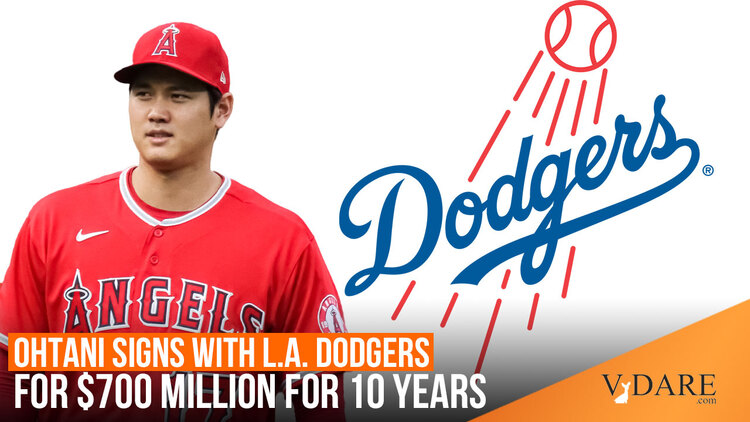


By Steve Sailer
12/10/2023
Nominally, that $700 million is the biggest contract in the history of sports, bigger even that Lionel Messi’s with Barcelona in 2017. It’s not really $70 million per season, though, because more than half of the payments will be deferred until some point in the future. But no details have been released yet, so you can’t yet calculate the net present value of the deal.
Over the last three seasons, Japan’s unique pitcher-slugger has been worth 28.5 wins above a replacement-quality player (i.e., a fill-in player that could be readily obtained from the minor leagues or from another team). Half is from his value as a starting pitcher, half from his slugging as a designated hitter.
That’s a huge figure for modern baseball outside of the steroid level. For example, from 1990-1992, a pre-PED Barry Bonds in his prime was worth 26.7 and in the same years, Roger Clements was worth 27.0.
I don’t think the following list includes all the examples of star players going back to the 1940s with a three year stretch of spectacular Wins Above Replacement, but it includes a lot of them. It show that Ohtani’s 2021-2023 run ranks among the legends.
| Star | Years | WAR |
| Willie Mays | 1963-1965 | 32.9 |
| Barry Bonds PEDs | 2001-2003 | 32.8 |
| Mickey Mantle | 1955-1957 | 32.6 |
| Ted Williams | 1941-1946 | 31.0 |
| Bob Gibson | 1968-1970 | 30.5 |
| Wilbur Wood | 1971-1973 | 30.0 |
| Joe Morgan | 1974-1976 | 29.2 |
| Shohei Ohtani | 2021-2023 | 28.5 |
| Roger Clements PEDs | 1996-1998 | 27.8 |
| Mike Trout | 2014-2016 | 27.8 |
| Stan Musial | 1948-1950 | 27.7 |
| Randy Johnson | 2007-2009 | 27.7 |
| Albert Pujols | 2007-2009 | 27.7 |
| Alex Rodriguez | 2000-2002 | 27.5 |
| Ernie Banks | 1958-1960 | 27.4 |
| Robin Roberts | 1952-1954 | 27.2 |
| Hank Aaron | 1961-1963 | 27.1 |
| Roger Clemens pre-PEDs | 1990-1992 | 27.0 |
| Barry Bonds pre-PEDs | 1991-1993 | 26.9 |
| Mookie Betts | 2016-2018 | 26.6 |
| Phil Niekro | 1977-1979 | 26.3 |
| Jackie Robinson | 1949-1951 | 26.3 |
| Tom Seaver | 1971-1973 | 26.0 |
| Sandy Koufax | 1963-1965 | 26.0 |
| Cal Ripken | 1989-1991 | 25.7 |
| Mike Schmidt | 1974-1976 | 25.5 |
| Greg Maddux | 1994-1996 | 25.4 |
| Roberto Clemente | 1966-1968 | 25.4 |
| Wade Boggs | 1985-1987 | 25.4 |
| Ken Griffey Jr. | 1996-1998 | 25.4 |
| Ferguson Jenkins | 1969-1971 | 24.6 |
| Robin Yount | 1982-1984 | 23.7 |
| Curt Schilling | 2001-2003 | 23.3 |
| Clayton Kershaw | 2013-2015 | 23.1 |
| Max Scherzer | 2016-2018 | 21.4 |
| Aaron Judge | 2021-2023 | 21.1 |
| Jacob DeGrom | 2017-2019 | 20.9 |
| Pete Rose | 1972-1974 | 20.2 |
| Marcus Semien | 2021-2023 | 20.2 |
| Bryce Harper | 2015-2017 | 16.1 |
| Gerrit Cole | 2021-2023 | 15.6 |
Baseball appears to be getting harder to dominate for three years in a row the way Ohtani has. If you go back to the beginning of the 20th Century, fireballer Walter Johnson had 40.0 WAR from 1912-1914 and Babe Ruth 34.1 from 1926-1928. In contrast, Bryce Harper is considered a superstar of the current game, but his best three year stretch only adds up to 16.1.
Probably the most forgotten name on the above list is knuckleballer Wilbur Woods who pitched an insane number of innings for the Chicago White Sox in the early 1970s.
In any case, it’s a risky deal for the Dodgers because it’s not clear if Shohei Ohtani will ever pitch again. He’ll take next year off from pitching due to surgery late last season. He apparently will be able to swing the bat in 2024. Last season he was the best hitter in the American League.
On the other hand, when not pitching, Ohtani has been playing designated hitter. And it’s not all that hard to get a lot of production out of the DH spot. For example, last season the Dodgers signed aged slugger J.D. Martinez to a one year deal for $10 million and got a ton of power out of him.
If Ohtani is washed up as a pitcher, he presumably can play left or right field and be a modest defensive asset on top of his bat, and let somebody less athletic DH.
Ohtani is 2.5 years younger than when Albert Pujols signed his disastrous 10-year-deal with the California Angels in 2012.
The Dodgers, a very smart franchise, presumably have theories for how they will pay Ohtani’s huge contract. Presumably, they figure on extracting revenue from Japanese in Japan in various ways.
The Los Angeles Dodgers made a fortune off of Mexican pitcher Fernando Valenzuela by making the Dodgers even more popular with Mexican-Americans in Southern California than they had already been. Before that, Sandy Koufax had gladdened Southern California’s large Jewish population.
The Japanese-American population isn’t that big, but perhaps the Dodgers think Ohtani will galvanize the Asian-American population in general, both in SoCal and nationally.
On the other hand, Ohtani doesn’t speak much English, is a private person who doesn’t go out much (I recall a news story that Ohtani going out to a restaurant during the mid-season All Star break was the first time he’d set foot in a restaurant since spring training), and cultivates a pleasantly boring image. The most famous thing about him off the field is that during the off-season he works out six hours per day and sleeps 12 hours per day.
All in all, I expect a ticket to Dodger Stadium will be even less affordable than it already is.